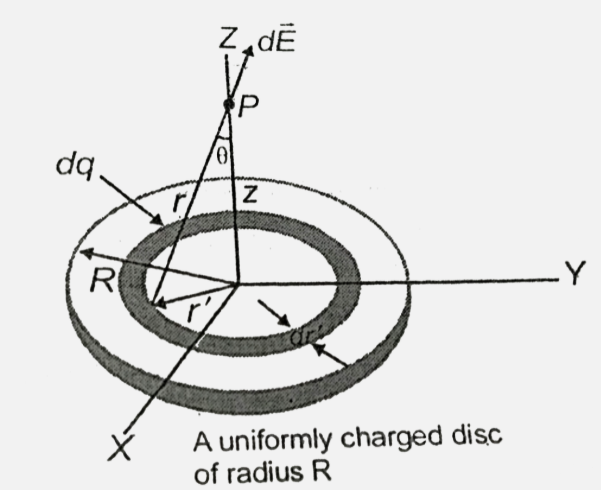A uniformly charged disc of radius R with a total charge Q lies in the XY -plane. Find the electric field at a point at a point P, along the Z-a xis that passes through the centre of the discc perpendicular to its plane. Discuss the limit when R>>z.
Strategy : By treating the disc as a set of concentric uniformly charged rings, the problem could be solved by using the result obtained in example for ring. Consider a ring of radius of radius r' and thickness as shown in figure.

By symmetry arguments the electric field at P points in the +z direction . Since the ring has charge dq=σ(2πr'dr') , we see that the ring givesa contribution.

dEz=14πε0zdq(r'2+z2)3/2=14πε0z(2πσr'dr')(r'2+z2)3/2
integrating from '=0 to r'=R the total electric fieldat P becomes.
Ez=∫dEz=σz2ε0∫R0r'dr'(r'r+z2)3/2=σz4ε0∫R2+z2z2duu3/2=σz4ε0u−1/2(−1/2))∣∣
∣∣R+z2z2
=−σz2ε0[1√R2+z2−1z]=σ2ε0[1−z√R2+z2]
⇒Ez=σ2ε0[1−z√R2+z2]
To show that the "point-charge" limit the recovered for z>>R, we make use of the Binomial expansion
1−z√z2+R2=1−(1−R2z2)−1/2=1−(1−12R2z2+.....)=12R2z2
This gives
Ez=σ2εR2z2=14πε0σπR2z2=14πε0Qz2
which is indeed the expected "point-charge" result . On the other hand, we may also consider the limit where R>>z. Physically this means that the plane is very large , or the field point P is extremely close to the surface of the plane. The electric field in this limit becomes,in unit-vector rotation.
→E=⎧⎪⎨⎪⎩σ2ε0ˆk,z>0−σ2ε0ˆk,z>0
Topper's Solved these Questions
- BOOK - AAKASH INSTITUTECHAPTER - ELECTRIC CHARGES AND FIELDS EXERCISE - TRY YOURSELF33videos
ELECTRIC CHARGES AND FIELDS
- BOOK - AAKASH INSTITUTECHAPTER - ELECTRIC CHARGES AND FIELDS EXERCISE - ASSIGNMENT(SECTION-A) Objective Type Question47videos
ELECTRIC CHARGES AND FIELDS
- BOOK - AAKASH INSTITUTECHAPTER - DUAL NATURE OF RADIATION AND MATTER EXERCISE - ASSIGNMENT (SECTION-D)10videos
DUAL NATURE OF RADIATION AND MATTER
- BOOK - AAKASH INSTITUTECHAPTER - ELECTROMAGNETIC INDUCTIONEXERCISE - ASSIGNMENT(SECTION -D) Assertion-Reason type Question)15videos
ELECTROMAGNETIC INDUCTION
Similar Questions
If a circular concentric hole is made on a disc then about an axis passing through the centre of the disc and perpendicular to its plane
View SolutionA uniformly charged disc of radius R having surface charge density σ is placed in the xy plane with its center at the origin. Find the electric field intensity along the z-axis at a distance Z from origin :
View Solution
Knowledge Check
- Question 1 - Select One or More
If a circular concentric hole is made on a disc then about an axis passing through the centre of the disc and perpendicular to its plane
Amoment of inertia decreasesBmoment of inertia increasesCradius of gyration increasesDradius of gyration decreases - Question 2 - Select One
The radius of gyration of a uniform disc of radius R, about an axis passing through a point R2 away from the centre of disc, and perpendicular to the plane of disc is:
A√12RB√2RC√32RD√34R
Calculate the moment of inertia of a disc of radius R and mass M, about an axis passing through its centre and perpendicular to the plane.
View SolutionA circular hole of radius r/2 is cut from a circular disc of radius 'r'. The disc lies in the xy plane. Determine the moment of inertia about an axis passing through the centre and perpendicular to the plane of the disc.
View SolutionA charge q is uniformly distributed on a non-conducting disc of radius R. It is rotated with an angular speed co about an axis passing through the centre of mass of the disc and perpendicular to its plane. Find the magnetic moment of the disc.
View SolutionA charge q is uniformly distributed on a non-conducting disc of radius R. It is rotated with an angular speed co about an axis passing through the centre of mass of the disc and perpendicular to its plane. Find the magnetic moment of the disc.
View SolutionA disc is kept on xy plane with centre at origin. Find electric field at a point with distance Z from origin on z-axis.
View SolutionConsider a uniformly charged ring of radius R and total charge Q. What is the magnitude of maximum possible electric field intensity on the axis of ring? What is the distance of point from the centre of ring at which the electric field is maximum?
View Solution

